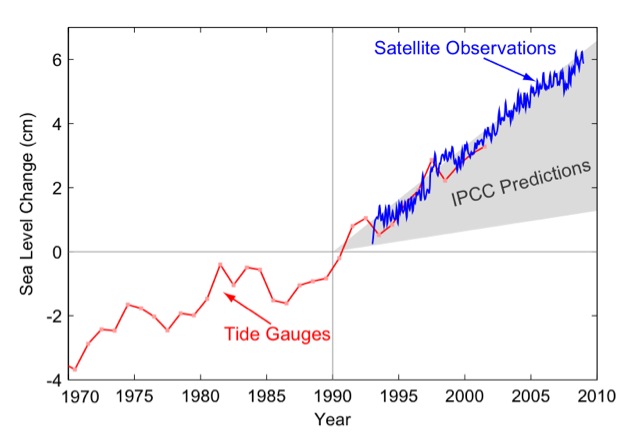Impacts of a melting cryosphere – ice loss around the world
This is a cross-post from the Carbon Brief.
With delicately balanced ecosystems, weather patterns and a lot of ice, the planet’s frozen areas (collectively known as the ‘cryosphere’) are some of the most sensitive to climate change. As the cryosphere warms, we can expect to see a range of knock-on effects. This briefing runs through what we know about how the cryosphere is reacting to climate change, and what the likely consequences of continued warming are.
The warming cryosphere
The cryosphere comprises of the Earth’s ice – notably the Arctic, the Antarctic, and the world’s glaciers.
Historical records suggest that Arctic sea ice began to decline around 1900, with a more accelerated ice loss since the 1950s. Since 1979, satellite records have confirmed an overall decline in summer sea ice coverage of around 13% per decade. Although fears that Arctic sea ice would reach a ‘tipping point’ and rapidly disappear currently seem to be unfounded, the mainstream view of scientists is that we will see ice-free summers in the Arctic ocean within the next few decades.
The major body of land ice in the Arctic - the Greenland ice sheet - has been found to be thickening inland. Nearer the coast, however, the ice sheet is thinning and shrinking, at an accelerating rate. Overall, the Greenland ice sheet has been found to be losing ice mass over the last twenty years, and this ice loss is becoming faster.
Antarctic ice consists of a land mass topped by an ice sheet and surrounded by sea ice. Antarctic sea ice extent is increasing at around 1% per decade, thought to be caused by shifting weather patterns reacting to changes in ozone, high in the atmosphere.
The 2007 IPCC report concluded that the Antarctic ice sheet was most likely losing ice overall – with the Antarctic Peninsula (in the west of the continent) warming and the eastern continental interior cooling slightly. The range of uncertainty in this assessment was large, with ice loss assessed as 24 gigatonnes per year, plus or minus 25 gigatonnes – i.e. somewhere between gaining 1 gigatonne and losing 49.
This considerable uncertainty is due in large part to the difficulty of obtaining measurements in such a harsh environment. However, recent research suggesting the whole of Western Antarctic is warming in winter and spring, while controversial in the media, has been supported by a subsequent borehole study.
Around the world, mountain glaciers are also losing ice mass. For example, a study of the Patagonian ice fields found that the rate of ice loss in the area has increased over the 20th century. Another group of scientists modelled around 120,000 glaciers around the world, concluding that they are likely to lose around a fifth of their ice volume over the next century.
The impacts of melting
The picture emerging from the scientific research is one of accelerated ice melting in every part of the cryosphere. Research has found that the environmental changes at both poles cannot result from natural climate change alone, and is directly attributable to man-made climate change.
This has knock-on effects. The cryosphere is an important part of our water cycle. Ice locks water out of the cycle for long periods of time – with large-scale melting, a vast amount of water can be released back into the water cycle in a relatively short amount of time.
Unsurprisingly, water from the current cryosphere melt is contributing to global sea level rise. As shown in the graph below, the observed increase in global sea level is currently at the upper limit of projections made by the IPCC in 1990.

Credit: The Copenhagen Diagnosis Report
As ice loss from both the polar ice sheets and mountain glaciers accelerates, global sea level rise is also set to increase. One recent study suggests that the Greenland and Antarctic ice sheets are likely to be the dominant contributor to sea level rise in the 21st century, providing around half of all sea level rise over the next 40 years. Ice melt from glaciers is also likely to play an important role.
Given current melting rates, and taking thermal heat expansion of the oceans into account, total sea level rise is estimated to be around 32 cm by 2050.
Melting ice also has implications for water supply, with many millions of people around the globe dependent on rivers fed by mountain glaciers. For example, in the Indus and Brahmaputra basins alone around 60 million people rely on glacial meltwater for their water supply.
With glaciers melting faster, the IPCC has suggested that in the short term summer river flow is likely to increase - but further into the future river flow is likely to decrease as the ice feeding rivers disappears.
Other impacts
Permafrost – ground frozen for at least two years - contains large amounts of carbon, stored as frozen methane or organic material unable to decay in its frozen state.
Researchers from the National Snow and Ice Data Center (NSIDC) estimate that if permafrost melt continues, around 190 gigatonnes of carbon could be released into the atmosphere by 2200, further warming the planet. To put this figure in context, in the year 2010 manmade greenhouse gas emissions were at around 30 gigatonnes.
Scientists are also warning of a more immediate potential threat from melting permafrost, suggesting that methane released from seafloor permafrost in the Arctic Ocean could enhance ocean acidification in that region over the next century.
For more information about the melting cryosphere & sea level variability:
Posted by Verity on Thursday, 9 June, 2011


